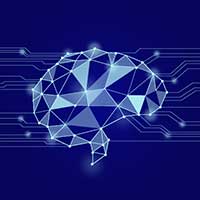Computer Vision in Medical Research

Computers are excellent assistants when it comes to performing high-volume, structured tasks. Scientists got great progress in makink computers understand what is presented in an image. This technology is called “computer vision” and it is applied in many spheres of life, for example, in medicine.
Computer vision is used for:
Segmentation of MRI images. The layout of MRI images of the brain on anatomical structure is an important step for further analysis by radiologist. Automatic image recognition enhances the interpretation of the results and shows increase in an early detection of bad cells and tissues.
Analysis of ultrasound images. Finding the exact nerve structure in ultrasound images is a crucial part of effectively inserting a catheter to block or reduce pain. Using computer vision can improve the accuracy of measurements for this procedure.
Automatic detection of circulating tumor cells. Early detection of such cells and assessment of disease progression is significant for effective treatment. In Image recognition it is possible to detect minor changes of sub-pixel size to drive to enhanced preventive therapy. Detection of such cells is impossible to be held by human.
COVID-19: from detection to treatment and prevention
The COVID-19 pandemic is an infection pandemic caused by the SARS-CoV-2 coronavirus. The pandemic began with the discovery in late December 2019 in the city of Wuhan in Central China’s Hubei province of the first cases of pneumonia of unknown origin.
A coronavirus is a potentially severe acute respiratory infection caused by the SARS-CoV-2 coronavirus. It is a dangerous disease that can occur both in the form of an acute respiratory viral infection of a light course. There also can be a severe form, specific complications of which may include viral pneumonia, resulting in acute respiratory distress syndrome or respiratory failure with a risk of death.
Today, the coronavirus pandemic is a global threat to all of humanity in all spheres, not just in the health sector. Therefore, the most important task is to effectively combat the spread of the disease, as well as its timely diagnosis.
First discovery of the virus and applied innovations

It is remarkable that artificial intelligence was able to detect the new coronavirus before we found it in medical research. On December 31 2019, BlueDot, a Toronto-based Outbreak Risk Software company tracked the first outbreak in Wuhan, and only then the local authorities diagnosed the first cases accordingly. The BlueDot team announced its findings and research discovery, almost a week before Chinese and international health organizations made official announcements. The innovation and artificial intelligence allowed BlueDot to get ahead of everyone.
This is why AI is considered to be a next phase of digital transformation. It is particularly important in life-saving and essential applications such as medicine.
For example, when it comes to medical research applications, AI models outperform human capacity to read a CT scan of lungs. In the context of current crisis, it may allow faster and more accurately recognize potential cases of COVID-19. Researches are currently on the pathway to create the new medications where massive data analysis is key. And we are equally excited to work with computer vision start ups to bring those solutions to hospitals faster. All these efforts are at an early stage, but the preliminary results are certainly encouraging.
How Computer Vision may aide further treatment of COVID-19
Fever Detection
Virus detection and classification
At the moment, thermometers are widely used to measure body temperature of visitors in public places. Medical professionals do this task manually. Equipment devices with infrared and camera image recognition can do the same at medical facilities and emergency hospitals. It allows to track fever of patients immediately. The speed of verification is up to 200 people per minute, and the accuracy of detection is 0.5 degrees C.
This technology is implemented by the Chinese company Baidu.
Alibaba, another Chinese tech giant, has developed an artificial intelligence system that is trained to detect coronavirus in a chest CT scan. The accuracy of this technology is reaching 97%. The detection speed is 20 seconds, while it takes a specialist more than 15 minutes to complete the same task. Moreover, the system can distinguish COVID-19 from common viral pneumonia.
Further development of this technology will help in creating home coronavirus detection kits.
New X-Ray system
Drone Delivery
Medtech, Nanox, an Israeli-based company, has developed a mobile digital X-Ray system that can be used to diagnose infections and prevent epidemic outbreaks. Currently, Nanox is being finalized, and soon it will be possible to use a new x-ray machine that will provide tomographic images of lungs.
Shenzhen MicroMultiCopter company announced the launch of 100 unmanned aerial vehicles in various cities in China. Drones equpied with infrared will measure body temperature of individuals. As well they can be deployed to spray disinfectants and patrol public places.
Beyond the medical research


